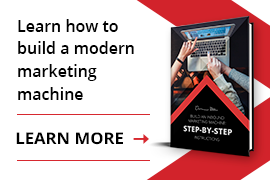
Not all leads are sales-ready after the first conversion. According to Marketo, approximately 96% of visitors that come to your website are not ready to buy. Instead, they’re more likely to be in the early stages of their buying journey - simply gathering information to define their problem and identifying possible solutions. You don’t want to lose a valuable lead simply because they’re not ready to buy, so what can you do? Using effective lead nurturing techniques, you can build a relationship with your prospects, positioning your brand as their trusted adviser. When they’re finally ready to make a purchase, you’ll be top of mind.
Make sure you’re employing these effective techniques in your business to build valuable relationships with your leads. Doing so will make your sales and marketing processes more effective, and lead to an increase in sales too. In fact, businesses who nurture leads make 50% more sales at a cost 33% less than non-nurtured prospects.
List Segmentation
The first thing you want to do when starting a lead nurturing program is to segment your contact list. Go back and look at any historical data that you have to try to separate your “best” customers from the “good” and “bad” ones. Using tools like Google Analytics and your own CRM, you can analyze both the demographics and the actions of your leads to gather valuable insights about their behavior.
For example, you could:
Start with all the leads you’ve acquired over the last 12 months. Sort the list into Sales Won and Sales Lost. Then sort your Sales Won segment by sale amount. Next, look at the length of the sales cycle or the cost it took you to service that client. Separate your Sales Won into 3 groups based on the largest sales value and shortest sales cycle (or lowest cost to serve).
Next, take your “best” customer list and try to identify any trends or commonalities between those customers. What was their referral source? What pages of your website did they view? What salesperson did they speak to? How many conversations did they have before purchase? And so on and so forth. Rinse and repeat for the “good” and “bad” customer segments.
Negative lead scores
“Why would I want to analyze “bad” customers?” you might be asking. Well, you can assign negative lead scores to potential customers who exhibit certain behaviors so that you know to steer clear of them in the future, saving you and your sales team valuable time and money.
Lead Scoring
After analyzing your customer segments, you should have a pretty good feel for what activities drove the most sales. Maybe it was prospects who read a particular whitepaper or viewed an explainer video. Maybe it was the fact that they viewed 5 or more pages on your website. Whatever it may be, assign points to each activity. Activities that were more successful in generating a sale should be assigned a higher point value than activities that rarely resulted in purchase.
For example:
10 points - watched a 20 min webinar
7 points - read an in-depth case study
5 points - watched a 2 minute explainer video
3 points - read 3 or more blog posts
1 point - visited the “About” page of your website
The next thing you need to do is integrate the points you’ve just assigned for each activity with your CRM platform. From now on, every time a potential customer performs these actions, they’ll accrue points in your CRM. These “lead scores”, will give you a good indication of each prospects’ likelihood to buy from you. You’ll have a reasonable view of your sales pipeline based on historical data of actions that your “best” customers have taken in their path to purchase.
Sales effectiveness
Lead scores can also highlight weaknesses in your marketing and sales process which you can use to make improvements. For example, you may find that leads who talk to sales rep A during the nurturing process are 10x more likely to purchase than leads who talk to sales rep B. Perhaps sales rep A can share call recording or notes with sales rep B, or even provide a little coaching on how he deals with common objections in his calls. After coaching, you should expect to see an improvement in sales rep B’s numbers.
Content Marketing
Content marketing plays a huge role in the lead nurturing process. As part of your content marketing strategy, you should have relevant pieces of content targeted to each of your buyer personas and for each stage of their buyer’s journey. The consideration and decision stage content is what you’ll be using to demonstrate your knowledge and expertise during the lead nurturing process.
Email Marketing
Email marketing campaigns are a great way to stay top of mind, and can be used to provide the lead with helpful, targeted content offers until they’re ready to purchase. With marketing automation software, the whole process can be automated so you can set it and forget (until it’s time to review your performance, anyway).
For example, let’s say you have a lead who filled in their contact details on a form on your website in exchange for a piece of awareness-level content. You know they’re interested in the topic, and they’re doing research on it. That awareness-level download could trigger an email workflow in your automation software which sends the prospect a sequence of relevant content offers designed to help educate them, convey your authority on the subject, and move them further down the sales funnel.
Other types of automated emails could include:
- Welcome emails - when a contact subscribes to your blog or joins a group/community that you facilitate.
- Thank you emails - either post-download, post-purchase or even after something as simple as making an insightful blog comment
- On-boarding emails - for new customers
- Monthly newsletters and updates
- Coupons and discounts
- Re-engagement emails - for leads or customers you haven’t interacted with in a while
- Cart abandonment emails (for eCommerce)
Email best practices
- As with blog posts, you want to make use of images, bullets, bolding and white space to make your email readable. It’s no secret that people have a short attention span these days, so you have a matter of seconds to convey your offer.
- The main thing you have to remember when creating your email workflows is that your emails need to be timely. Consider the length of your sales cycle. You want the cadence of your communications to feel natural, not annoying.
- Another best-practice is to use personalization - studies have shown that personalized emails generate up to 6 times higher revenue per email than non-personalized emails do.
Multi-Channel Lead Nurturing
Email is not the only way you can distribute your content offers. You can use a variety of other channels to communicate with your leads. Other digital channels like social media, push notifications and SMS campaigns can be just as effective (or even more so depending on the communication style of your audience). More traditional channels like phone calls and live events can also be effective ways to build relationships with your leads.
Summary
Successful lead nurturing is really about using the data and content you already have to create meaningful relationships with your leads in order to establish your credibility. Using the effective lead nurturing tactics covered in this post, you can help steer your prospects further down the path to purchase. And as with most things, remember to analyze and review on a regular basis in order to ensure that your tactics are delivering optimal results.

